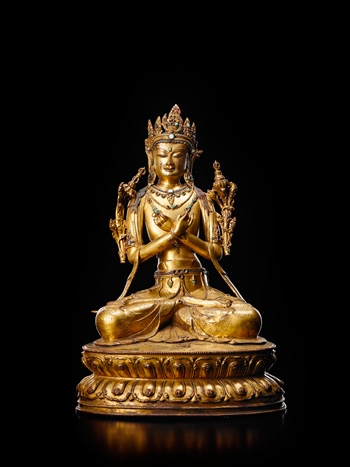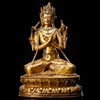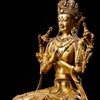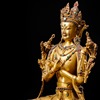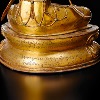The present lot of a seated Tara is the widely worshiped goddess of compassion, the turquoise inlaid adorning the crown is a common approach utilized to enhance the sumptuousness of the goddess. Tara is worshipped by laymen and lames across centuries and its great popularity coincided with the growth of Tantric worship early in western Tibet and subsequently had a profound influence on Buddhism. There are essentially twenty one forms of Tara and according to popular folklore, the legendary origin of Tara is related to the great Bodhisattva Avalokiteshvara. As he witnessed the ever-increasing misery of humanity, he shed an endless stream of tears of compassion streaming down his face and from the tears the White Tara was born from his left eye. It is highly probable that the present lot is a depiction of Sitatara (White Tara) as the gesture of her right hand in varada mudra and her crossed leg folded in padmasana signifies a trademark of the deity. Depictions of Tara in both painted as well as sculptural forms have been conceived, such as the impressive images of White Tara gracing the halls of the Patala palace, constructed by the Great Fifth Dalai Lama in 1645 above Lhasa over the ancient ruins of Songtsen Gambo's castle. Compare with another White Tara similarly adorned with a five panel crown and decorated with precious turquoise inlays, illustrated in The Museum of art in San Francisco, US, 1994, p.49.
|
8082
A GILT BRONZE SEATED FIGURE OF TARA
18TH CENTURY |
|
Seated with her legs folded in padmasana on a double lotus base, her right hand in vajrapradama with lotus blooming on either sides of her shoulders, the serene face of radiate opulence frame by a crown of five jeweled plaques below a network of elaborate jewelries festooned across her torso, wearing a dhoti of flowing rhythmic elegance embossed with rich foliate designs visible from the reverse. |
|
Estimate
800,000 - 1,280,000 3,125,000 - 5,000,000 103,100 - 164,900
|
|
Sold Price 960,000
3,720,930
123,871
|
|
|
The present lot of a seated Tara is the widely worshiped goddess of compassion, the turquoise inlaid adorning the crown is a common approach utilized to enhance the sumptuousness of the goddess. Tara is worshipped by laymen and lames across centuries and its great popularity coincided with the growth of Tantric worship early in western Tibet and subsequently had a profound influence on Buddhism. There are essentially twenty one forms of Tara and according to popular folklore, the legendary origin of Tara is related to the great Bodhisattva Avalokiteshvara. As he witnessed the ever-increasing misery of humanity, he shed an endless stream of tears of compassion streaming down his face and from the tears the White Tara was born from his left eye. It is highly probable that the present lot is a depiction of Sitatara (White Tara) as the gesture of her right hand in varada mudra and her crossed leg folded in padmasana signifies a trademark of the deity. Depictions of Tara in both painted as well as sculptural forms have been conceived, such as the impressive images of White Tara gracing the halls of the Patala palace, constructed by the Great Fifth Dalai Lama in 1645 above Lhasa over the ancient ruins of Songtsen Gambo's castle. Compare with another White Tara similarly adorned with a five panel crown and decorated with precious turquoise inlays, illustrated in The Museum of art in San Francisco, US, 1994, p.49.
